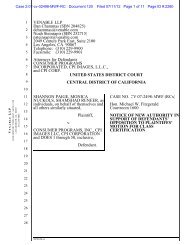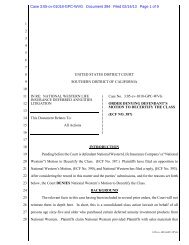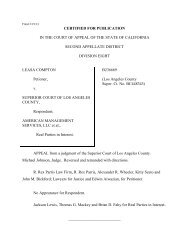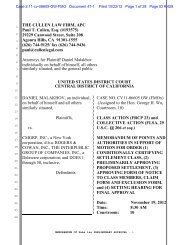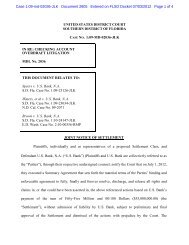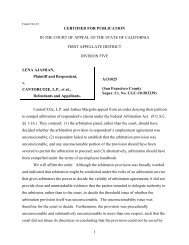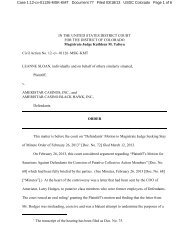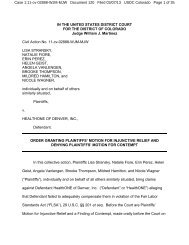KYLE PIPPINS, JAMIE SCHINDLER, and EDWARD LAMBERT
KYLE PIPPINS, JAMIE SCHINDLER, and EDWARD LAMBERT
KYLE PIPPINS, JAMIE SCHINDLER, and EDWARD LAMBERT
You also want an ePaper? Increase the reach of your titles
YUMPU automatically turns print PDFs into web optimized ePapers that Google loves.
2012 U.S. Dist. LEXIS 949, *; 18 Wage & Hour Cas. 2d (BNA) 1179<br />
Page 4<br />
To enable employees to enforce their rights under<br />
the FLSA, section 216(b) creates a private right of action<br />
to recover unpaid overtime compensation, <strong>and</strong> provides<br />
that employees may pursue their claims collectively:<br />
An action . . . may be maintained<br />
against any employer ... in any Federal or<br />
State court of competent jurisdiction by<br />
any one or more employees for <strong>and</strong> in<br />
behalf of himself or themselves <strong>and</strong> other<br />
employees similarly situated. No employee<br />
shall be a party plaintiff to any<br />
such action unless he gives his consent in<br />
writing to become such a party <strong>and</strong> such<br />
consent is filed in the court in which such<br />
action is brought.<br />
29 U.S.C § 216(b). The collective action procedure was<br />
designed to promote the "efficient adjudication of similar<br />
claims," so that "similarly situated" employees may pool<br />
resources to prosecute their claims. Lynch v. United<br />
Servs. Auto. Ass'n., 491 F. Supp. 2d 357, 367 (S.D.N.Y.<br />
2007) (citing [*12] Hoffmann-La Roche Inc. v.<br />
Sperling, 493 U.S. 165, 110 S. Ct. 482, 107 L. Ed. 2d 480<br />
(1989)). Unlike Federal Rule of Civil Procedure 23,<br />
however, the FLSA only authorizes opt-in collective<br />
actions. Kress, 263 F.R.D. at 626.<br />
There are three essential features in a FLSA collective<br />
action under section 216(b):<br />
First, in order to participate in a collective<br />
action, an employee must "opt-in,"<br />
meaning the employee must consent in<br />
writing to join the suit <strong>and</strong> that consent<br />
must be filed with the court. Second, the<br />
statute of limitations runs on each employee's<br />
claim until his individual Consent<br />
Form is filed with the court. Third, to better<br />
serve the FLSA's "broad remedial<br />
purpose," courts may order notice to other<br />
potential similarly situated employees to<br />
inform them of the opportunity to opt-in<br />
in the case.<br />
Lynch, 491 F. Supp. 2d at 367 (citing Hoffmann-La<br />
Roche, 493 U.S. at 173).<br />
Though section 216(b) neither explicitly provides<br />
for court-authorized notice nor requires it, it is "'well<br />
settled' that district courts have the power to authorize an<br />
FLSA plaintiff to send such notice." Gjurovich v. Emmanuel's<br />
Marketplace, Inc., 282 F. Supp. 2d 101, 103-04<br />
(S.D.N.Y. 2003) (quoting Hoffmann v. Sbarro, Inc.., 982<br />
F. Supp. 249, 260 (S.D.N.Y. 1997)); [*13] Myers v.<br />
Hertz Corp., 624 F.3d 537, 555 n.10 (2d Cir. 2010)<br />
("Thus certification is neither necessary nor sufficient for<br />
the existence of a representative action under FLSA, but<br />
maybe useful as a case management tool for district<br />
courts to employee in appropriate cases") (quoting<br />
Hoffmann-La Roche, 493 U.S. at 169, 174)). Orders that<br />
authorize notice to be sent are commonly referred to as<br />
orders "certifying" that a case be litigated as a collective<br />
action. Damassia v. Duane Reade, Inc., No. 04 Civ. 8819<br />
(GEL), 2006 U.S. Dist. LEXIS 73090, 2006 WL 2853971<br />
(S.D.N.Y. Oct. 5, 2006) (Lynch, J.).<br />
2. Overview of the FLSA's Two-Stage Certification<br />
Process<br />
Courts in the Second Circuit employ a two-stage<br />
process to determine whether such certification is proper.<br />
See, e.g., Raniere v. Citigroup Inc., F. Supp. 2d ,<br />
2011 U.S. Dist. LEXIS 135393, 2011 WL 5881926, at<br />
*22 (S.D.N.Y. Nov. 22, 2011); Lynch, 491 F. Supp. 2d at<br />
367-68; Cohen v. Gerson Lehrman Grp., Inc., 686 F.<br />
Supp. 2d 317, 327 (S.D.N.Y. 2010) ("The dominant approach<br />
among district courts in this Circuit is to conduct<br />
a two-phase inquiry in determining whether potential<br />
opt-in plaintiffs are 'similarly situated.'"); Myers, 624<br />
F.3d at 554 (approving of the two-step method in dicta).<br />
In the [*14] first stage, the Court makes a preliminary<br />
determination about whether the named plaintiffs <strong>and</strong><br />
potential opt-in plaintiffs are sufficiently "similarly situated"<br />
to authorize the sending of notice <strong>and</strong> allow the<br />
case "to proceed as a collective action through discovery."<br />
Lynch, 491 F. Supp. 2d at 368. If the court finds<br />
that the named plaintiffs <strong>and</strong> potential opt-ins are indeed<br />
"similarly situated" with respect to their job duties/requirements;<br />
compensation <strong>and</strong> employer policies,<br />
the court "conditionally certifies" the collective action.<br />
Id. (citing Iglesias-Mendoza v. La Belle Farm, Inc., 239<br />
F.R.D. 363, 367 (S.D.N.Y. 2007)). The plaintiffs then<br />
send court-approved notice to potential members, who<br />
may elect to opt-in to the collective action by filing consent<br />
forms with the court, <strong>and</strong> the now-collective action<br />
proceeds to discovery. Id. Because the clock is running<br />
on the claims of potential opt-in plaintiffs all the while,<br />
conditional certification is to be decided early in the litigation<br />
process, so that class members' claims do not become<br />
time-barred.<br />
At the second stage -- after discovery <strong>and</strong> upon the<br />
defendant's request -- district courts must undergo a more<br />
stringent factual analysis [*15] to determine whether<br />
the collective action members are in fact similarly situated.<br />
Espinoza, 2011 U.S. Dist. LEXIS 132098, 2011 WL<br />
5574895, at *6; Indergit, 2010 U.S. Dist. LEXIS 60202,<br />
2010 WL 2465488, at *4. The court may decertify the<br />
action if the record reveals that the employees are not



